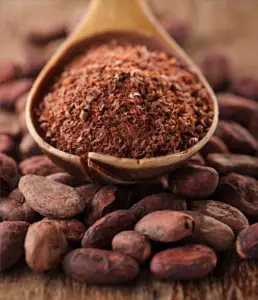
Why in news?
- Cocoa is one of the most important and alluring substances in the world of confectionery.
- Cocoa farming is a cornerstone of the global agricultural landscape, since it is responsible for the production of popular chocolates around the world.
- However, recent events have highlighted the insecure nature of cocoa production, notably in the crucial regions of Ivory Coast and Ghana, which together account for 60% of global cocoa output.
The Origins and Geography of Cocoa:
- The cocoa industry has long roots in tropical countries, dating back to South America’s lush Amazon basin.
- Today, it thrives in locations around the equator, between 20 degrees north and south. Understanding cocoa’s geographical and climatic characteristics is critical to successful cultivation.
Climatic and Soil Requirements:
- Cocoa plants flourish in environments with a delicate balance of moisture and warmth. They require an annual rainfall ranging from 1500 to 2000 mm and thrive within a temperature range of 15°C to 39°C, with an optimum of 25°C.
- Soil characteristics play a crucial role, with deep, well-drained soils, predominantly clay loam and sandy loam, serving as the nurturing ground for cocoa cultivation, with an ideal pH range of 6.5 to 7.0.
Shade Requirement and Plantation Design:
- Cocoa’s development as an understorey crop in Amazonian rainforest emphasizes its need for shade.
- Commercial cultivation flourishes in areas where the canopy receives around 50% of the light, which influences plantation design and management procedures to ensure maximum growth and productivity.
Challenges in Cocoa Production:
- Cocoa cultivation confronts many hurdles, despite its tropical roots.
- Recent disruptions in Ivory Coast and Ghana underscore the industry’s sensitivity to external variables such as climate change, political unrest, and economic volatility.
- A lack of cocoa beans has forced the near-shutdown of processing factories, causing vibrations throughout the global chocolate market and emphasizing the industry’s need for resilience and adaptability.
Opportunities for Diversification and Innovation:
- Adversity creates possibilities for diversification and innovation. While West African countries dominate cocoa production, places such as India are carving out a position in the business.
- Cocoa is grown as an intercrop with arecanut and coconut in regions such as Karnataka, Kerala, and Tamil Nadu, demonstrating the versatility of this cherished crop.
Sustainability and Ethical Sourcing:
- Sustainable and ethical sourcing initiatives are gaining traction in the cocoa sector.
- From fair trade certificates to agroforestry practices, stakeholders are actively looking for solutions to reduce environmental effect while improving cocoa farmers’ lives.
- This shift toward transparency and accountability poses both problems and opportunities for cocoa growers, encouraging innovation and redefining the industry’s future.
Conclusion:
- The world of cocoa production is a complex tapestry woven with tradition, innovation, and challenges.
- While recent disruptions underscore the fragility of the industry, they also serve as a catalyst for transformation and growth.
- By embracing sustainability, resilience, and collaboration, stakeholders can navigate the bittersweet journey of cocoa production towards a brighter and more sustainable future.
People also ask
Q1: What is the significance of cocoa production in the global agricultural landscape?
Ans: Cocoa production plays a crucial role in the creation of chocolates worldwide and serves as a cornerstone of the confectionery industry.
Q2: Where does cocoa cultivation originate, and where does it thrive today?
Ans: Originally from the Amazon basin of South America, cocoa cultivation now thrives in tropical regions around the equator, between 20 degrees latitude north and south.
Q3: What are the key climatic and soil requirements for successful cocoa cultivation?
Ans: Cocoa plants require a delicate balance of moisture and warmth, with an annual rainfall of 1500 to 2000 mm and a temperature range of 15°C to 39°C. They thrive in well-drained soils like clay loam and sandy loam, with an ideal pH range of 6.5 to 7.0.
Q4. How does shade influence cocoa plantation design and management?
Ans: Cocoa evolved as an understorey crop in the Amazonian forests, indicating its preference for shade. Commercial cultivation often involves ensuring approximately 50% of light permeates the canopy, influencing plantation design and management practices.
Your point of view caught my eye and was very interesting. Thanks. I have a question for you.
Can you be more specific about the content of your article? After reading it, I still have some doubts. Hope you can help me.
Thank you for your sharing. I am worried that I lack creative ideas. It is your article that makes me full of hope. Thank you. But, I have a question, can you help me?